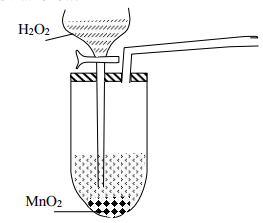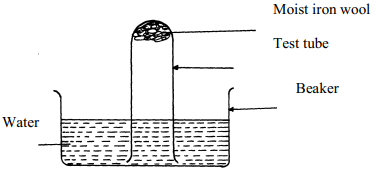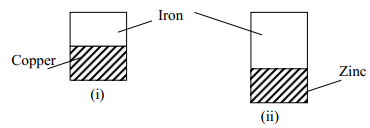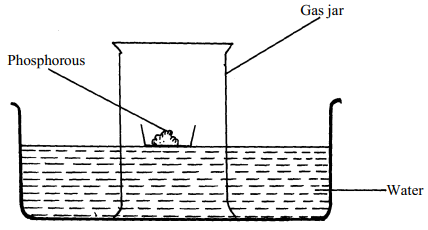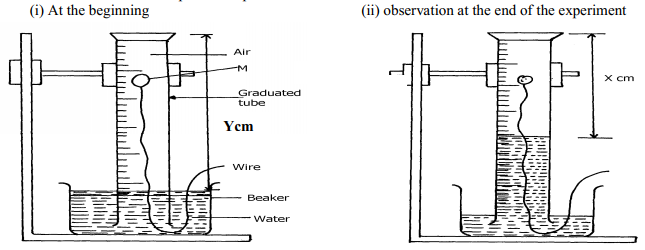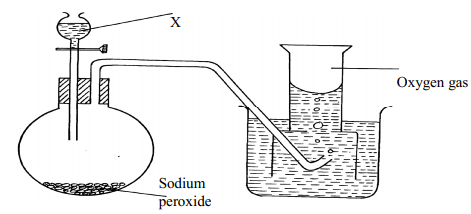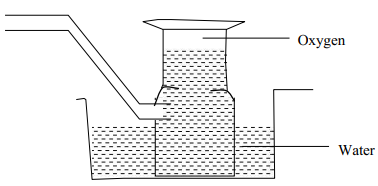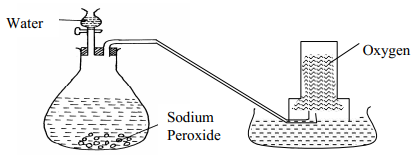Questions
- The set-up below was used to prepare a sample of oxygen gas. Study it and answer the questions that follow.
- Complete the diagram to show how Oxygen can be collected
- Write a chemical equation of the reaction to produce oxygen
- Complete the diagram to show how Oxygen can be collected
- Air was passed through several reagents as shown below:
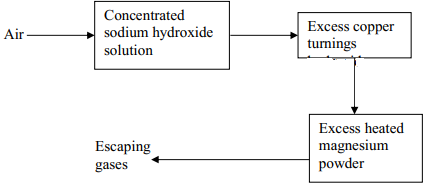
- Write an equation for the reaction which takes place in the chamber containing magnesium powder
- Name one gas which escapes from the chamber containing magnesium powder. Give a reason for your answer
- What is rust?
- Give two methods that can be used to prevent rusting
- Name one substance which speeds up the rusting process
- 3.0g of clean magnesium ribbon 8.0g of clean copper metal were burnt separately in equal volume of air and both metals reacted completely with air;
- State and explain where there was greater change in volume of air Mg =24 Cu = 64
- Write an equation for the reaction between dilute sulphuric acid and product of burnt copper
- Oxygen is obtained on large scale by the fractional distillation of air as shown on the flow chart below.
- Identify the substance that is removed at the filtration stage
- Explain why Carbon (IV) oxide and water are removed before liquefaction of air
- Identify the component that is collected at -186°C
- The set-up below was used to study some properties of air.
State and explain two observations that would be made at the end of the experiment - A form two student in an attempt to stop rusting put copper and Zinc in contact with iron as shown:-
- State whether rusting occurred after one week if the set-ups were left out
- Explain your answer in (a) above
- In an experiment, a piece of magnesium ribbon was cleaned with steel wool. 2.4g of the clean magnesium ribbon was placed in a crucible and completely burnt in oxygen. After cooling the product weighed 4.0g
- Explain why it is necessary to clean magnesium ribbon
- What observation was made in the crucible after burning magnesium ribbon?
- Why was there an increase in mass?
- Write an equation for the major chemical reaction which took place in the crucible
- The product in the crucible was shaken with water and filtered. State and explain the observation which was made when red and blue litmus paper were dropped into the filtrate
- In an experiment a gas jar containing some damp iron fillings was inverted in a water trough containing some water as shown in the diagram below. The set-up was left un-disturbed for three days. Study it and answer the questions that follow:
- Why were the iron filings moistened?
- State and explain the observation made after three days.
- State two conclusions made from the experiment.
- Draw a labelled set-up of apparatus for the laboratory preparation of oxygen using sodium Peroxide
- State two uses of oxygen
- The set-up below was used to collect gas F produced by the reaction between sodium peroxide and water
- Name gas F……………………………………………………………………………
- At the end of the experiment, the solution in the round bottomed flask was found to be a strong base. Explain why this was so
- Which property of gas F makes it be collected by the method used in the set-up?
- Give one industrial use of gas F
- The set-up below was used to investigate properties of the components of air:
- State two observations made during the experiment
- Write two chemical equations for the reactions which occurred
- The experiment was repeated using burning magnesium in place of phosphorous.
There was greater rise of water than in the first case. Explain this observation - After the two experiments, the water in each trough was tested using blue and red litmus papers. State and explain the observations of each case.
- Phosphorous experiment
- magnesium experiment
- Briefly explain how a sample of nitrogen gas can be isolated from air in the laboratory
- A group of students burnt a piece of Mg ribbon in air and its ash collected in a Petri dish. The ash was found to comprise of magnesium Oxide and Magnesium nitride
- Write an equation for the reaction leading to formation of the magnesium nitride
- A little water was added to the products in the Petri dish. State and explain the observation made.
- A piece of blue litmus paper was dipped into the solution formed in (b) above.
State the observation made.
- A form one class carried out an experiment to determine the active part of air. The diagram below shows the set-up of the experiment and also the observation made.
- Identify substance M ..................................................................................
- State two reasons for the suitability of substance M for this experiment
- Write the equation for the reaction of substance M and the active part of air
- Using the letters Y and X write an expression for the percentage of the active part of air
- The expression in (c)(i) above gives lower value than the expected. Explain
- Explain the observation made when litmus paper is dipped into the beaker at the end of the experiment
- Name the active part of air ................................................................................................
- Suggest another method that can be used to determine the active part of air
- A piece of phosphorous was burnt in excess air. The product obtained was shaken with a small amount of hot water to make a solution
- Write an equation for the burning of phosphorus in excess air
- The solution obtained in (b) above as found to have pH of 2. Give reasons for this observation
- Study the set-up below and answer the questions that follow:-
- State two observations that would be made after one week. Explain
- Write the equation of the reaction taking place in the test-tube
- Fe3O4 and FeO are oxides of iron which can be produced in the laboratory
- Write chemical equation for the reaction which can be used to produce each of the oxides
- Wire an ionic equation for the reaction between the oxide, Fe3O4 and a dilute acid.
- Below is a list of oxides.
MgO, N2O, K2O, CaO ans Al2O3
Select:-- A neutral oxide.
- A highly water soluble basic oxide.
- An oxide which can react with both sodium hydroxide solution and dilute hydrochloric acid.
- The diagram below shows students set-up for the preparation and collection of oxygen gas
- Name substance X used
- Write an equation to show the reaction of sodium peroxide with the substance named in 1(a)
- Name substance X used
Answers
-
-
- 3Mg(s)+ N2(g) → Mg3N2(g)
- Argon
- It is inert
-
- Rust is hydrated iron (III) Oxide
- - Electroplating
- Painting
- Oiling
- Galvanization - - Salts
- Acids
-
- Moles of copper 8/64 = 0.125 moles of Mg 3/24 = 0.125Mg reacts with both O2 and N2 gases in the air while copper reacts with O2 only
There is greater change in the reaction with copper and smaller change in reaction with Mg - CUO(g) + H2SO4(aq) → CUSO4(aq) + H2O(l)
Balanced
Chemical symbols correct
State symbols correct
- Moles of copper 8/64 = 0.125 moles of Mg 3/24 = 0.125Mg reacts with both O2 and N2 gases in the air while copper reacts with O2 only
-
- Dust particles
- They readily solidify hence may block the pipes
- Argon
- - Water rose up the test-tube to occupy the space of active air √½ which has been used in resting. √½
- Iron wool turned reddish – brown √½ due formation of red-oxide of iron √½ which is rust. -
- rusting occurred√ ½
- No rusting√ ½
- In (i) iron is more reactive than copper hence undergoes corrosion√1 in (ii) zinc is more reactive than iron hence undergoes corrosion in place of iron√1
-
- To remove any magnesium oxide coating from the surface of magnesium// To remove any oxide film on it
- White solid which is magnesium oxide
- Increase in mass was due to oxygen which combined with magnesium
- 2Mg(s) + O2(g) → 2MgO(s)
Penalize ½ for wrong or missing state symbols - The filtrate is magnesium hydroxide which is an alkaline
Red litmus paper changed blue, but blue litmus paper remained blue
-
- So that they may stick to the gas Jar to prevent them from falling into water when the gas jar is inverted
- Iron filings turned to reddish brown because they reacted with oxygen in presence of moisture to form rust.
- The level of water inside the gas jar rise so as to occupy the volume initially occupied by part of air used up for rusting - - Air is made up of two parts; - the active part that is necessary for rusting and the inactive part that is not used for rusting
- oxygen is the active part of air -
- Neat diagram-
- correct method of collection - - For cutting and welding metals
- Rocket fuel
- Mountain climbing
- Sea diving
- Used in explosions (any two)
-
- Oxygen
- Sodium hydroxide is a strong base
- Slightly soluble in water
-
- White fumes form in the gas jar which disappear after sometime.
- The level of water rises in the gas jar. - P(s) + O2(g) → P2O5(s)
P2O(s) + 3H2O(l) → 2H4PO4(aq) - Magnesium react with oxygen and nitrogen hence greater of fraction of air is used.
- Blue litmus changed to red as red remained red. The solution was acid due to phosphoric
- Red litmus changed to blue as blue remained blue due to formation of basic magnesium hydroxide ammonia solution.
- – Pass air over conc. KOH/NaOH to absorb CO2
- Pass the remaining gases over hot copper solid which reacts with oxygen.
- Collect the remaining gas over water. The gas is mainly nitrogen.
- White fumes form in the gas jar which disappear after sometime.
-
- 3Mg(s) + N2(g) → Mg3N2(s) √1
- Gas with√1 choking irritating smell.
Mg3N2 reacts with water to form ammonia √1 gas. - It remains blue. √½ Ammonia gas is alkaline. √½
-
-
- Phosphorous
- - Do not react with water when being inserted into the tube
- reacts with oxygen when exposed to air.
- 4P(s) + 3O2(g) →2P2O3(s)
or 4P(s) + SO2(g) → 2P2O5(s) -
- (Y – X)/y x 100
- – Wrong reading of volume
- Phosphorous can go off before complete combustion
-
- – Red litmus paper no effect
- Blue litmus paper turns red due to formation of phosphoric acid/phosphorous (V) Oxide whish is an acidic oxide - – Oxygen
- – Burning of candle
- Use of pyrogallol
- Rusting of iron fillings
- – Red litmus paper no effect
-
-
- P4(g) + 5O2(g) → 2P2O5(s)
// P4(s) + 3O2(g) → 2P2O3(g) Anyone ✓1 mark - Phosphorous (v) or (iii) oxide formed is an acidic Oxide which dissolves in water to form a strong acidic solution of phosphoric acid whose PH is 2
- P4(g) + 5O2(g) → 2P2O5(s)
-
- - Iron nails turns brown.
- Water rises up the delivery tube/water level drops in the trough ( any ½mk)
Explanation: Oxygen has been used up in rusting of iron nails hence water rises up to take the place of oxygen - 4Fe(s) + 3O2(g) + 2H2O(l) → 2Fe2O3.2H2O(s)
(accept a balanced chemical equation)
- - Iron nails turns brown.
-
- FeCO3(s) → FeO(s) + CO2(g)
Fe(s) + 4H2O(g) → FeO4(s) + 4H2(g)
Or
2 Fe(s) + 202(g) → Fe3O4(s) - Fe3O4(s) + 8H+(aq) → 4H2O (l) + 2Fe3+(aq) + Fe2+(aq)
- FeCO3(s) → FeO(s) + CO2(g)
-
- N2O ✓1 (Nitrogen (I) oxide) – Denitrogen Oxide.
- K2O ✓1 (Potassium oxide)
- Al2O3 (Aluminium oxide)
-
- water √1
- 2Na2O2(s) + 2H2O(l) → 4NaOH(aq) + O2(g) √1 mk
Penalize ½ - wrong missing state symbols
Join our whatsapp group for latest updates
Tap Here to Download for 50/-
Get on WhatsApp for 50/-
Download Air and Combustion Questions and Answers - Chemistry Form 1 Topical Revision.
Tap Here to Download for 50/-
Get on WhatsApp for 50/-
Why download?
- ✔ To read offline at any time.
- ✔ To Print at your convenience
- ✔ Share Easily with Friends / Students

